Revealing Nonlinear and Spatial Interaction Effects of Built Environment on Ride-Hailing Demand in Nanjing, China
Abstract
1. Introduction
2. Literature Review
2.1. BE and Ride-Hailing Demand
2.2. Related Models
3. Methodology
3.1. Study Region and Ride-Hailing Demand
3.2. Independent Variable
3.3. Methods
3.3.1. RF Model
3.3.2. GeoShapley Method
4. Results
4.1. Collinearity Test and Model Performance
4.2. Importance and Nonlinear Effects
4.3. Spatial Interaction Effects of the BE
5. Conclusions
Author Contributions
Funding
Data Availability Statement
Conflicts of Interest
Appendix A. Summary Statistics of GeoShapley Values
| Min | 25% | 50% | 75% | Max | Mean | Std | abs. Mean | |
| LUM | −0.863 | −0.222 | 0.122 | 0.177 | 0.254 | −0.024 | 0.278 | 0.221 |
| DCC × GEO | −0.464 | 0.029 | 0.117 | 0.208 | 0.467 | 0.116 | 0.123 | 0.138 |
| GEO | −0.516 | −0.204 | −0.079 | 0.004 | 0.410 | −0.095 | 0.135 | 0.129 |
| DCC | −0.312 | −0.160 | −0.066 | 0.045 | 0.294 | −0.058 | 0.124 | 0.115 |
| RL | −0.473 | −0.078 | 0.059 | 0.076 | 0.125 | −0.003 | 0.127 | 0.100 |
| DMS | −0.275 | −0.081 | −0.006 | 0.074 | 0.227 | −0.003 | 0.097 | 0.084 |
| LUM × GEO | −0.400 | 0.002 | 0.048 | 0.088 | 0.496 | 0.048 | 0.088 | 0.076 |
| PD | −0.100 | −0.047 | −0.032 | 0.050 | 0.160 | −0.004 | 0.060 | 0.053 |
| DBS | −0.260 | −0.009 | 0.011 | 0.038 | 0.075 | −0.001 | 0.057 | 0.039 |
| DMS × GEO | −0.176 | −0.019 | 0.004 | 0.034 | 0.153 | 0.006 | 0.047 | 0.035 |
| RL × GEO | −0.318 | −0.014 | 0.004 | 0.029 | 0.320 | 0.006 | 0.046 | 0.032 |
| PD × GEO | −0.251 | −0.017 | 0.002 | 0.026 | 0.262 | 0.008 | 0.046 | 0.030 |
| HP | −0.186 | −0.005 | 0.005 | 0.012 | 0.065 | −0.003 | 0.030 | 0.018 |
| HP × GEO | −0.172 | −0.004 | 0.008 | 0.019 | 0.076 | 0.006 | 0.022 | 0.017 |
| DBS × GEO | −0.164 | −0.009 | 0.002 | 0.013 | 0.152 | 0.001 | 0.025 | 0.017 |
| BSD | −0.012 | −0.006 | −0.001 | 0.006 | 0.058 | 0 | 0.007 | 0.006 |
| BSD × GEO | −0.040 | −0.003 | 0 | 0.002 | 0.057 | 0 | 0.005 | 0.003 |
| MSD | −0.002 | −0.001 | −0.001 | 0 | 0.025 | 0 | 0.003 | 0.001 |
| MSD × GEO | −0.009 | 0 | 0 | 0 | 0.019 | 0 | 0.001 | 0.001 |
References
- Lesteven, G.; Samadzad, M. Ride-hailing, a new mode to commute? Evidence from Tehran, Iran. Travel Behav. Soc. 2021, 22, 175–185. [Google Scholar] [CrossRef]
- Chung, J.; Namkung, O.S.; Ko, J.; Yao, E. Cycling distance and detour extent: Comparative analysis of private and public bikes using city-level bicycle trajectory data. Cities 2024, 151, 105134. [Google Scholar] [CrossRef]
- Wang, X.; Yin, C.; Zhang, J.; Shao, C.; Wang, S. Nonlinear effects of residential and workplace built environment on car dependence. J. Transp. Geogr. 2021, 96, 103207. [Google Scholar] [CrossRef]
- Zhao, F.; Ma, J.; Yin, C.; Tang, W.; Wang, X.; Yin, J. Spatiotemporal heterogeneous effects of built environment and taxi demand on ride-hailing ridership. Appl. Sci. 2024, 14, 142. [Google Scholar] [CrossRef]
- Ghaffar, A.; Mitra, S.; Hyland, M. Modeling determinants of ridesourcing usage: A census tract-level analysis of Chicago. Transp. Res. Part C Emerg. Technol. 2020, 119, 102769. [Google Scholar] [CrossRef]
- Zhao, D.; Yuan, Z.; Chen, M.; Yang, S. Differential pricing strategies of ride-sharing platforms: Choosing customers or drivers? Int. Trans. Oper. Res. 2022, 29, 1089–1131. [Google Scholar] [CrossRef]
- Yin, J.; Zhao, F.; Tang, W.; Ma, J. The Nonlinear and Threshold Effect of Built Environment on Ride-Hailing Travel Demand. Appl. Sci. 2024, 14, 4072. [Google Scholar] [CrossRef]
- Si, R.; Lin, Y.; Yang, D.; Guo, Q. Interpretable machine learning insights into the factors influencing residents’ travel distance distribution. ISPRS Int. J. Geo-Information 2025, 14, 39. [Google Scholar] [CrossRef]
- Yin, C.; Gui, C.; Xu, Z.; Shao, C.; Wang, X. Revisiting built environment and vehicle kilometer traveled: Does car ownership matter? Transp. Res. Part D Transp. Environ. 2025, 144, 104798. [Google Scholar] [CrossRef]
- Yin, C.; Shao, C. Revisiting commuting, built environment and happiness: New evidence on a nonlinear relationship. Transp. Res. Part D Transp. Environ. 2021, 100, 103043. [Google Scholar] [CrossRef]
- Ewing, R.; Cervero, R. Travel and the built environment: A meta-analysis. J. Am. Plan. Assoc. 2010, 76, 265–294. [Google Scholar] [CrossRef]
- Yin, C.; Zhang, J.; Shao, C.; Wang, X. Commute and built environment: What matters for subjective well-being in a household context? Transp. Policy 2024, 154, 198–206. [Google Scholar] [CrossRef]
- Wang, X.; Han, J.; Yin, C.; Shao, C.; Zhang, J. Built environment and travel satisfaction revisited: Differences between consonant and dissonant travelers. Transp. Res. Part A Policy Pract. 2025, 192, 104375. [Google Scholar] [CrossRef]
- Ding, C.; Wang, Y.; Tang, T.; Mishra, S.; Liu, C. Joint analysis of the spatial impacts of built environment on car ownership and travel mode choice. Transp. Res. Part D Transp. Environ. 2018, 60, 28–40. [Google Scholar] [CrossRef]
- Du, Q.; Zhou, Y.; Huang, Y.; Wang, Y.; Bai, L. Spatiotemporal exploration of the non-linear impacts of accessibility on metro ridership. J. Transp. Geogr. 2022, 102, 103380. [Google Scholar] [CrossRef]
- Newman, P. The environmental impact of cities. Environ. Urban. 2006, 18, 275–295. [Google Scholar] [CrossRef]
- Yin, C.; Wang, X.; Shao, C.; Ma, J. Exploring the relationship between built environment and commuting mode choice: Longitudinal evidence from China. Int. J. Environ. Res. Public Health 2022, 19, 14149. [Google Scholar] [CrossRef]
- Du, M.; Li, Z.; Li, X.; Xu, J.; Liu, D.; Kwan, M.P. Understanding the Spatial Variation of Integrated Use of Ride-Hailing Services With the Metro. J. Adv. Transp. 2024, 2024, 9210901. [Google Scholar] [CrossRef]
- Liu, Z.; Chen, H.; Sun, X.; Chen, H. Data-driven real-time online taxi-hailing demand forecasting based on machine learning method. Appl. Sci. 2020, 10, 6681. [Google Scholar] [CrossRef]
- Liu, Z.; Chen, H.; Li, Y.; Zhang, Q. Taxi demand prediction based on a combination forecasting model in hotspots. J. Adv. Transp. 2020, 2020, 1302586. [Google Scholar] [CrossRef]
- Liu, Z.; Chen, H. Short-term online taxi-hailing demand prediction based on the multimode traffic data in metro station areas. J. Transp. Eng. Part A Syst. 2022, 148, 05022003. [Google Scholar] [CrossRef]
- Wang, S.; Noland, R.B. Variation in ride-hailing trips in Chengdu, China. Transp. Res. Part D Transp. Environ. 2021, 90, 102596. [Google Scholar] [CrossRef]
- Sabouri, S.; Park, K.; Smith, A.; Tian, G.; Ewing, R. Exploring the influence of built environment on Uber demand. Transp. Res. Part D Transp. Environ. 2020, 81, 102296. [Google Scholar] [CrossRef]
- Yu, H.; Peng, Z.-R. Exploring the spatial variation of ridesourcing demand and its relationship to built environment and socioeconomic factors with the geographically weighted Poisson regression. J. Transp. Geogr. 2019, 75, 147–163. [Google Scholar] [CrossRef]
- Li, X.; Xu, J.; Du, M.; Liu, D.; Kwan, M.-P. Understanding the spatiotemporal variation of ride-hailing orders under different travel distances. Travel Behav. Soc. 2023, 32, 100581. [Google Scholar] [CrossRef]
- Alemi, F.; Circella, G.; Handy, S.; Mokhtarian, P. What influences travelers to use Uber? Exploring the factors affecting the adoption of on-demand ride services in California. Travel Behav. Soc. 2018, 13, 88–104. [Google Scholar] [CrossRef]
- Siddiq, F.; Taylor, B.D. A gendered perspective on ride-hail use in Los Angeles, USA. Transp. Res. Interdiscip. Perspect. 2024, 23, 100938. [Google Scholar] [CrossRef]
- Gomez, J.; Aguilera-García, Á.; Dias, F.F.; Bhat, C.R.; Vassallo, J.M. Adoption and frequency of use of ride-hailing services in a European city: The case of Madrid. Transp. Res. Part C Emerg. Technol. 2021, 131, 103359. [Google Scholar] [CrossRef]
- Yan, X.; Liu, X.; Zhao, X. Using machine learning for direct demand modeling of ridesourcing services in Chicago. J. Transp. Geogr. 2020, 83, 102661. [Google Scholar] [CrossRef]
- Zhang, B.; Chen, S.; Ma, Y.; Li, T.; Tang, K. Analysis on spatiotemporal urban mobility based on online car-hailing data. J. Transp. Geogr. 2020, 82, 102568. [Google Scholar] [CrossRef]
- Huang, G.; Qiao, S.; Yeh, A.G.-O. Spatiotemporally heterogeneous willingness to ridesplitting and its relationship with the built environment: A case study in Chengdu, China. Transp. Res. Part C Emerg. Technol. 2021, 133, 103425. [Google Scholar] [CrossRef]
- Dean, M.D.; Kockelman, K.M. Spatial variation in shared ride-hail trip demand and factors contributing to sharing: Lessons from Chicago. J. Transp. Geogr. 2021, 91, 102944. [Google Scholar] [CrossRef]
- Shen, X.; Zhou, Y.; Jin, S.; Wang, D. Spatiotemporal influence of land use and household properties on automobile travel demand. Transp. Res. Part D Transp. Environ. 2020, 84, 102359. [Google Scholar] [CrossRef]
- Liu, F.; Gao, F.; Yang, L.; Han, C.; Hao, W.; Tang, J. Exploring the spatially heterogeneous effect of the built environment on ride-hailing travel demand: A geographically weighted quantile regression model. Travel Behav. Soc. 2022, 29, 22–33. [Google Scholar] [CrossRef]
- Cao, Y.; Tian, Y.; Tian, J.; Liu, K.; Wang, Y.; Ustaoglu, E. Impact of built environment on residential online car-hailing trips: Based on MGWR model. PLoS ONE 2022, 17, e0277776. [Google Scholar] [CrossRef] [PubMed]
- Luo, Y.; Huang, A.; He, Z.; Zeng, J.; Wang, D. Exploring competitiveness of taxis to ride-hailing services from a multidimensional spatio-temporal perspective: A case study in Beijing, China. J. Transp. Geogr. 2024, 118, 103936. [Google Scholar] [CrossRef]
- Bi, H.; Ye, Z.; Zhu, H. Examining the nonlinear impacts of built environment on ridesourcing usage: Focus on the critical urban sub-regions. J. Clean. Prod. 2022, 350, 131314. [Google Scholar] [CrossRef]
- Li, W.; Zhao, S.; Ma, J.; Nielsen, O.A.; Jiang, Y. Book-ahead ride-hailing trip and its determinants: Findings from large-scale trip records in China. Transp. Res. Part A Policy Pract. 2023, 178, 103875. [Google Scholar] [CrossRef]
- Lai, J.; Wang, Y.; Yang, Y.; Wu, X.; Zhang, Y. Exploring the built environment impacts on Online Car-hailing waiting time: An empirical study in Beijing. Comput. Environ. Urban Syst. 2025, 115, 102205. [Google Scholar] [CrossRef]
- Li, W.; Ma, J.; Cai, H.; Chen, F.; Qin, W. The role of built environment in shaping reserved ride-hailing services: Insights from interpretable machine learning approach. Res. Transp. Bus. Manag. 2024, 56, 101173. [Google Scholar] [CrossRef]
- Ji, S.; Wang, X.; Lyu, T.; Liu, X.; Wang, Y.; Heinen, E.; Sun, Z. Understanding cycling distance according to the prediction of the XGBoost and the interpretation of SHAP: A non-linear and interaction effect analysis. J. Transp. Geogr. 2022, 103, 103414. [Google Scholar] [CrossRef]
- Peng, B.; Zhang, Y.; Li, C.; Wang, T.; Yuan, S. Nonlinear, threshold and synergistic effects of first/last-mile facilities on metro ridership. Transp. Res. Part D Transp. Environ. 2023, 121, 103856. [Google Scholar] [CrossRef]
- Wu, J.; Jia, P.; Feng, T.; Li, H.; Kuang, H. Spatiotemporal analysis of built environment restrained traffic carbon emissions and policy implications. Transp. Res. Part D Transp. Environ. 2023, 121, 103839. [Google Scholar] [CrossRef]
- Yin, C.; Zhang, J.; Shao, C. Relationships of the multi-scale built environment with active commuting, body mass index, and life satisfaction in China: A GSEM-based analysis. Travel Behav. Soc. 2020, 21, 69–78. [Google Scholar] [CrossRef]
- Wang, X.; Wang, W.; Yin, C.; Shao, C.; Luo, S.; Liu, E. Relationships of life satisfaction with commuting and built environment: A longitudinal analysis. Transp. Res. Part D Transp. Environ. 2023, 114, 103513. [Google Scholar] [CrossRef]
- Wang, X.; Shao, C.; Yin, C.; Guan, L. Built environment, life events and commuting mode shift: Focus on gender differences. Transp. Res. Part D Transp. Environ. 2020, 88, 102598. [Google Scholar] [CrossRef]
- Ewing, R.; Cervero, R. Travel and the built environment: A synthesis. Transp. Res. Rec. J. Transp. Res. Board 2001, 1780, 87–114. [Google Scholar] [CrossRef]
- Agarwal, S.; Charoenwong, B.; Cheng, S.-F.; Keppo, J. The impact of ride-hail surge factors on taxi bookings. Transp. Res. Part C: Emerg. Technol. 2022, 136, 103508. [Google Scholar] [CrossRef]
- Yang, L.; Yu, B.; Liang, Y.; Lu, Y.; Li, W. Time-varying and non-linear associations between metro ridership and the built environment. Tunn. Undergr. Space Technol. 2023, 132, 104931. [Google Scholar] [CrossRef]
- Li, Z. GeoShapley: A Game Theory Approach to Measuring Spatial Effects in Machine Learning Models. Ann. Assoc. Am. Geogr. 2024, 114, 1365–1385. [Google Scholar] [CrossRef]
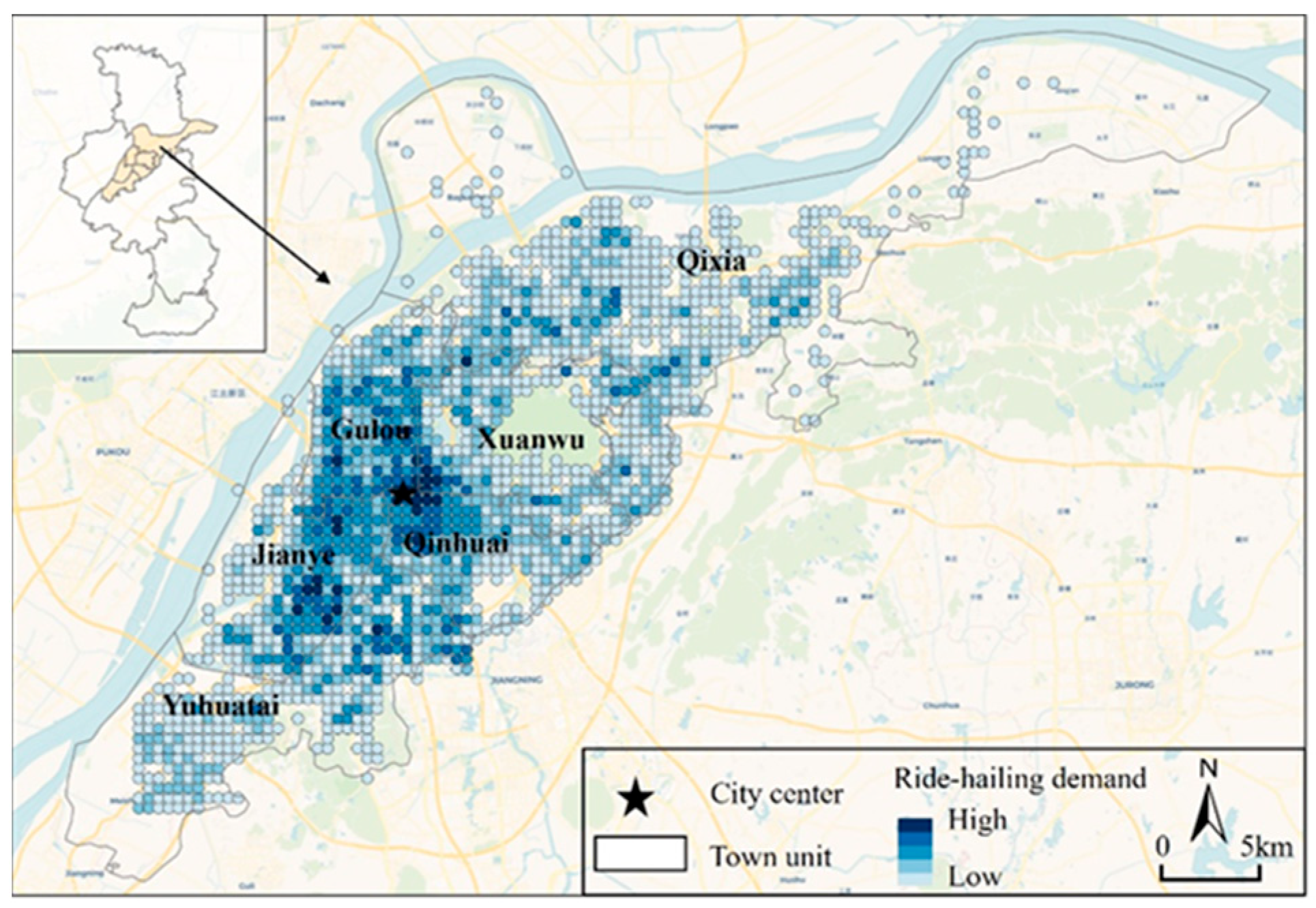
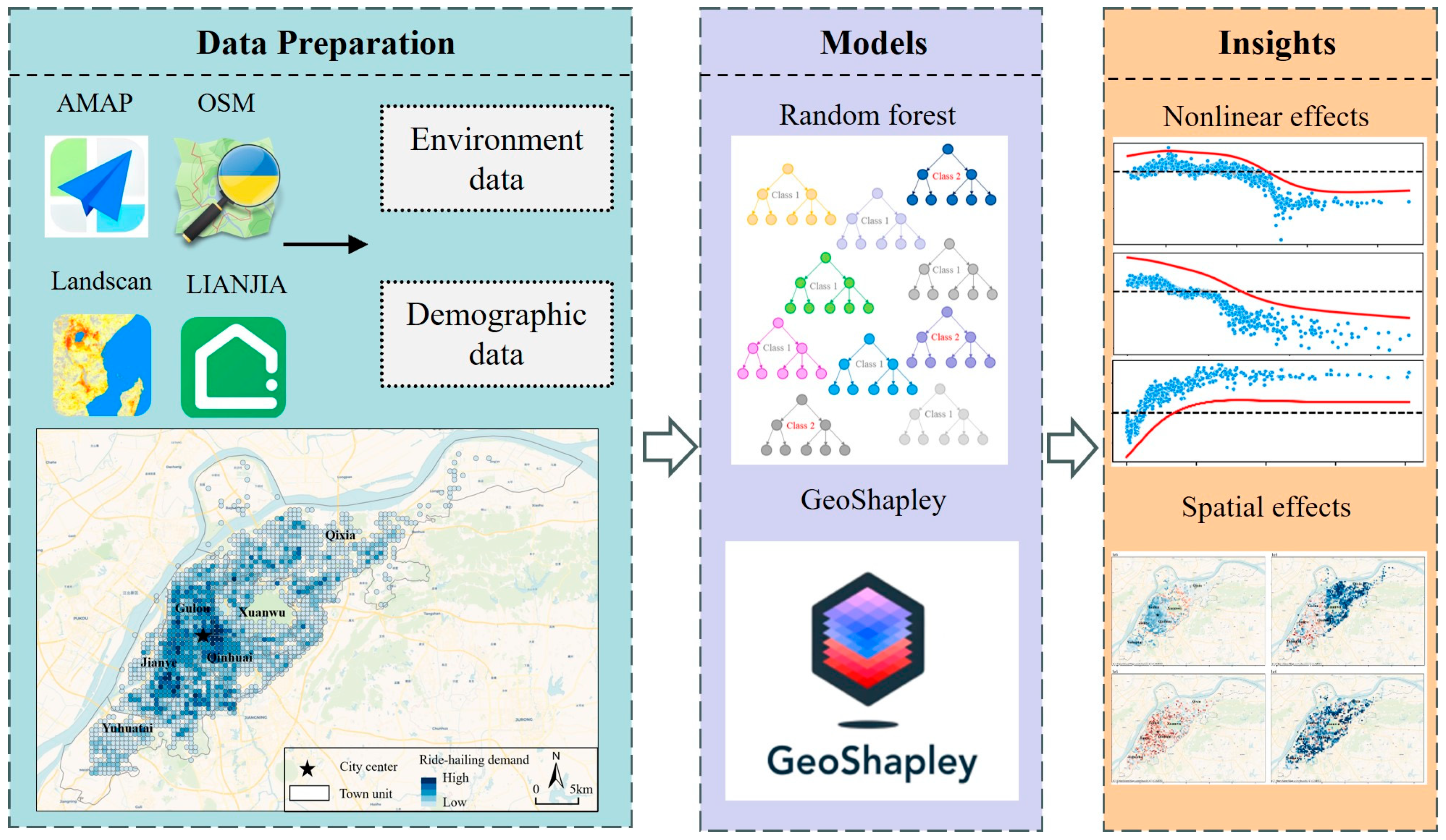
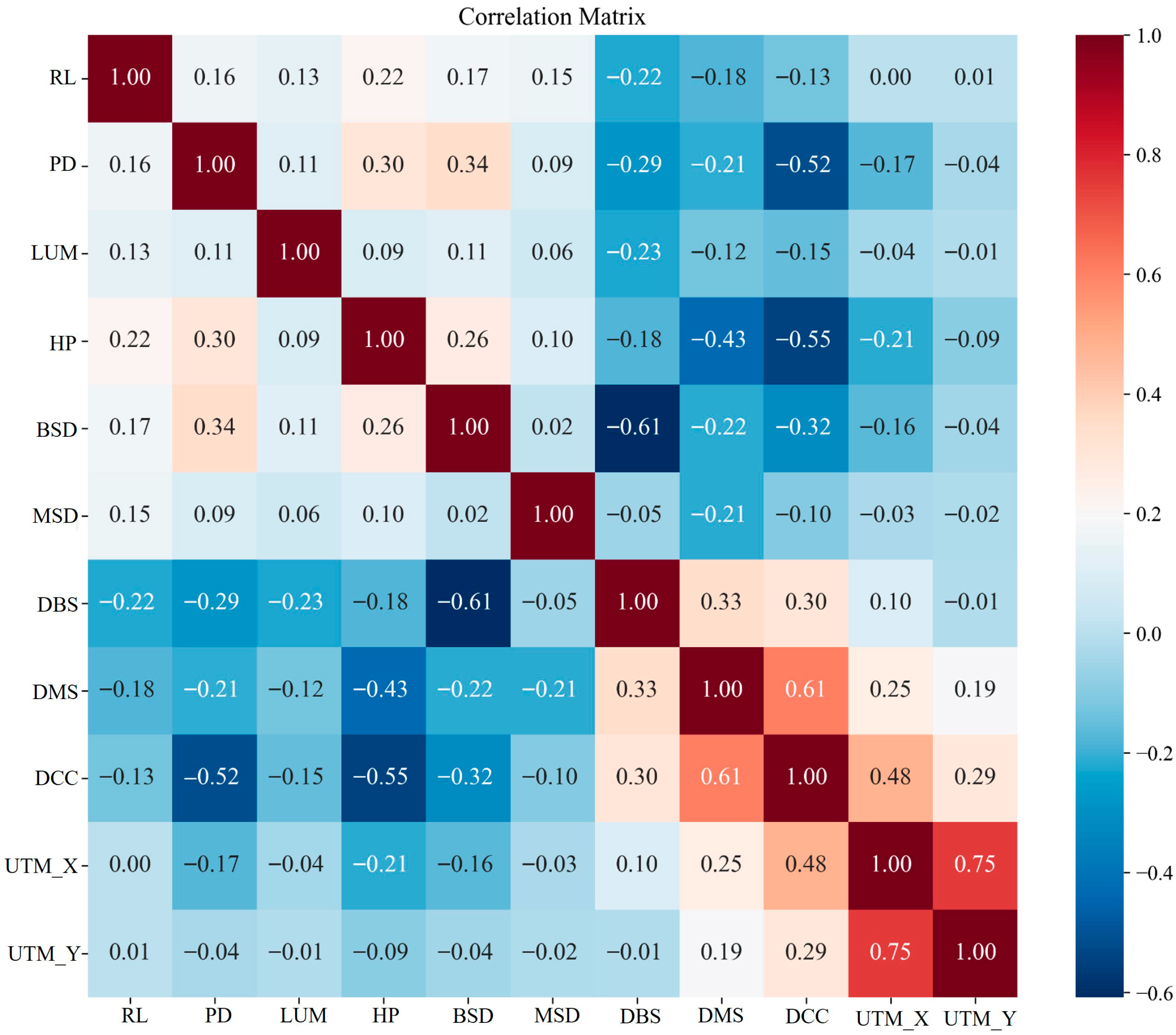


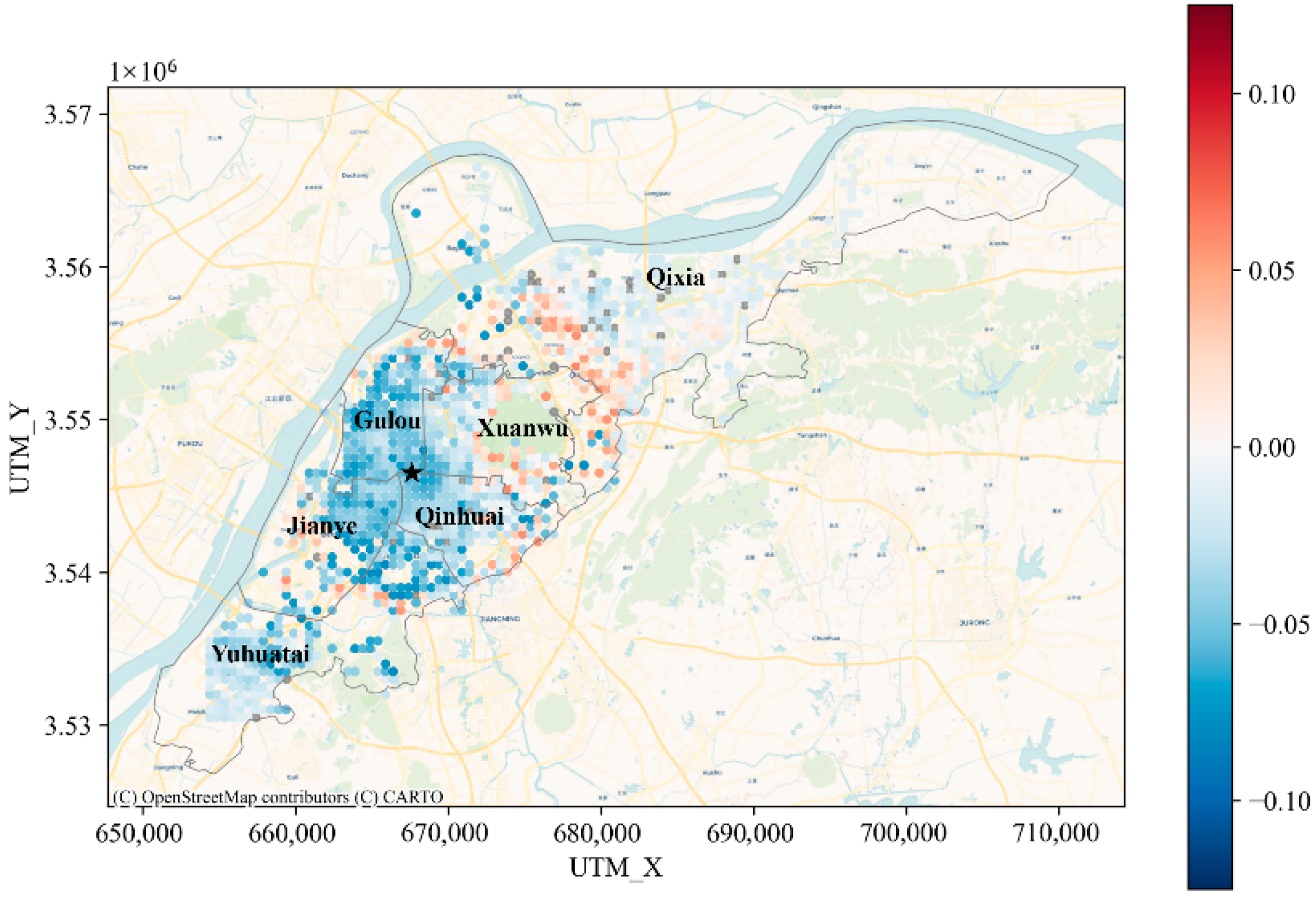
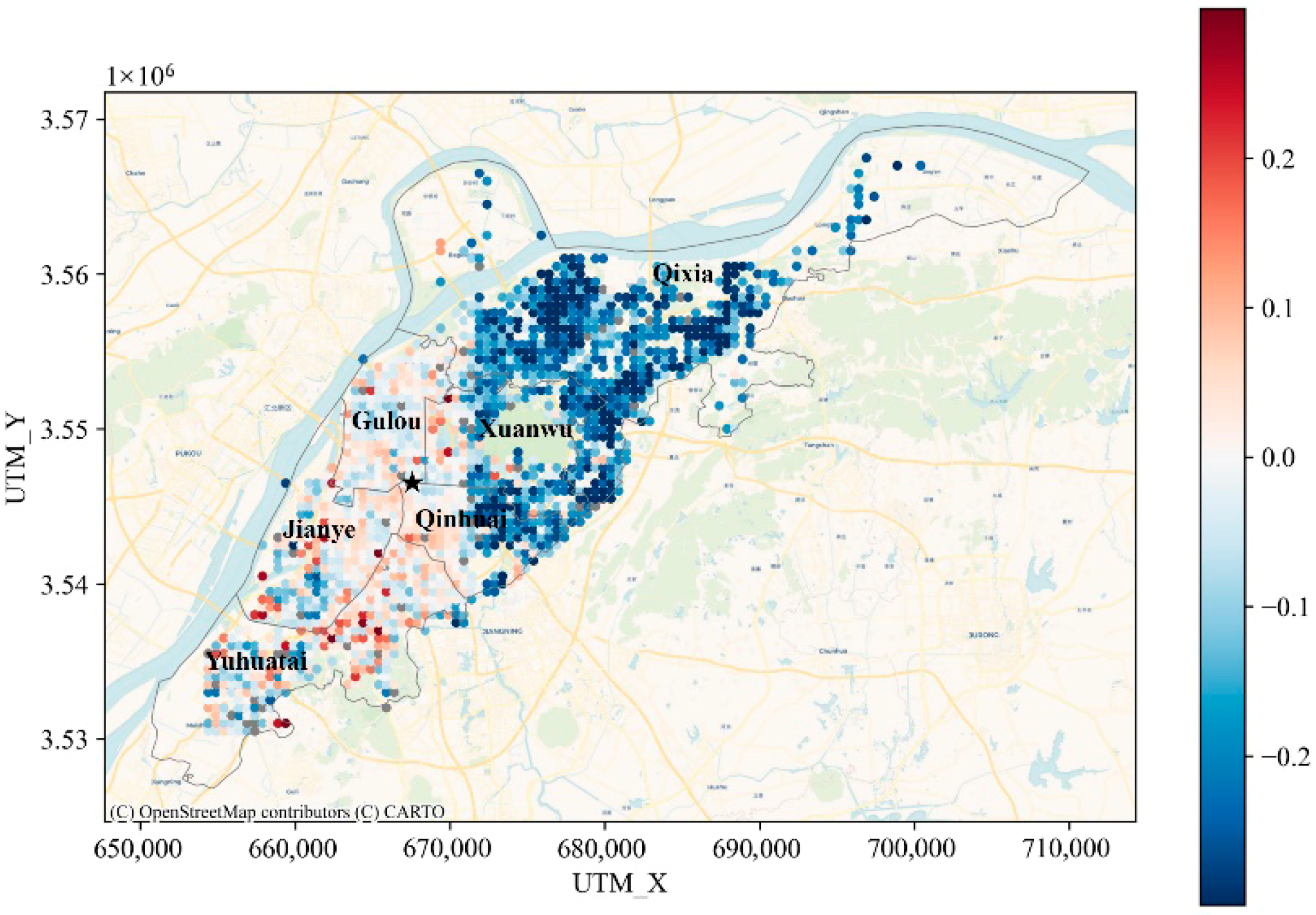

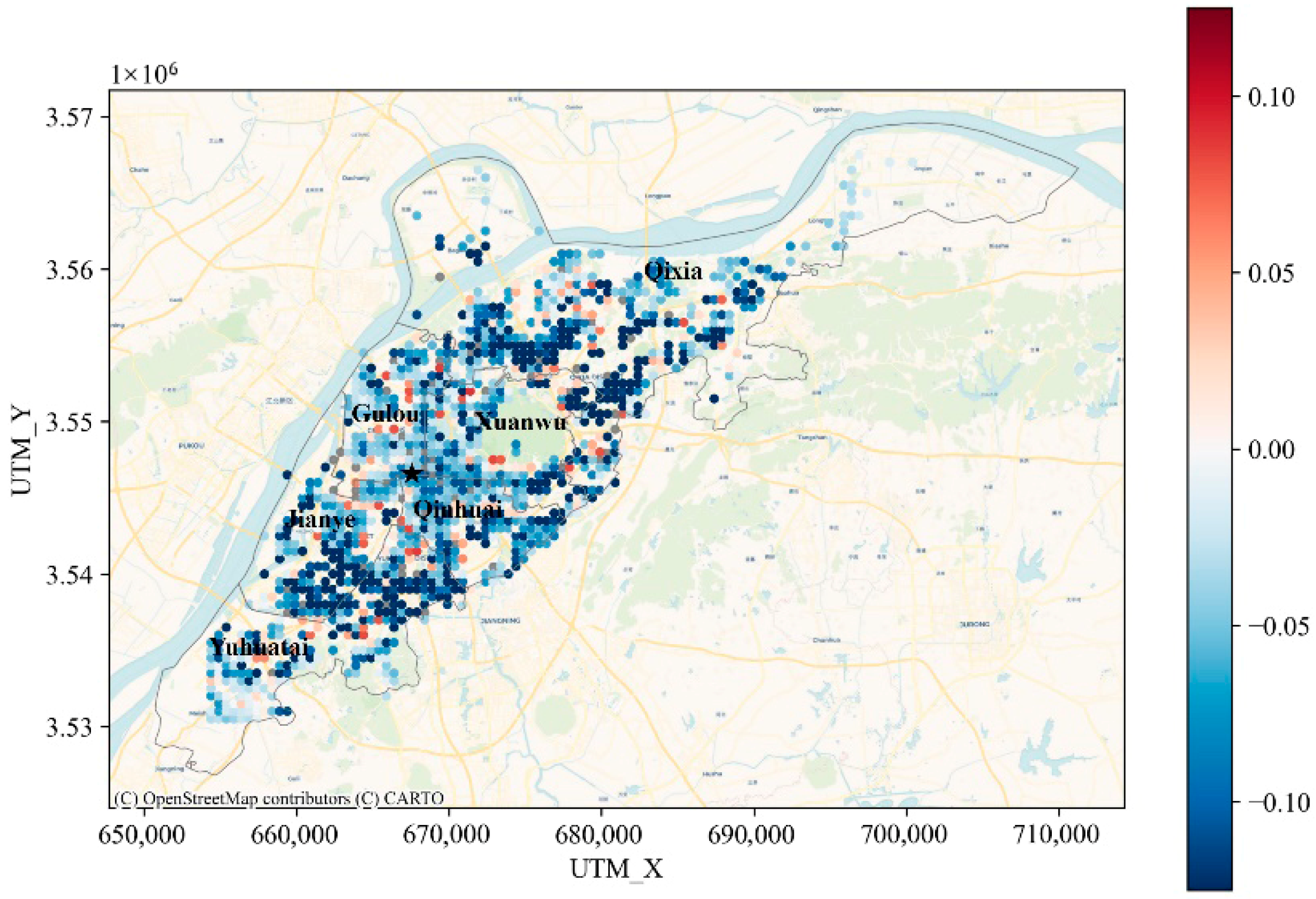
| Variables | Description | Mean | St. Dev. |
|---|---|---|---|
| Dependent variables | |||
| Ride-hailing demand | Ride-hailing travel demand of all transportation network companies within each grid (count) | 69.45 | 99.74 |
| Independent variable | |||
| Density | |||
| Population density (PD) | The population size within the grid (persons) | 2980 | 4737 |
| Design | |||
| Road length (RL) | The road length within the grid (km) | 2.49 | 1.39 |
| Diversity | |||
| Land use mixture (LUM) | The entropy index of the 7 types of POIs within the grid | 0.77 | 0.25 |
| Destination accessibility | |||
| Distance to city center (DCC) | Euclidean distance from the city center (km) | 10.55 | 6.03 |
| Distance to transit | |||
| Distance to bus stop (DBS) | Euclidean distance from the nearest bus stop (km) | 0.33 | 0.25 |
| Distance to metro stop (DMS) | Euclidean distance from the nearest metro stop (km) | 1.57 | 1.62 |
| Bus stop density (BSD) | The number of bus stops within the grid (count) | 0.93 | 1.11 |
| Metro stop density (MSD) | The number of metro stops within the grid (count) | 0.06 | 0.24 |
| Demographic | |||
| Housing price (HP) | The average residential HP within the grid (ten thousand yuan) | 3.32 | 1.17 |
| Geographic location | |||
| UTM_X | The longitude of the grid centroid point | 671,093.74 | 8648.63 |
| UTM_Y | The latitude of the grid centroid point | 3,547,446.48 | 7896.26 |
| R2 | RMSE | MAE | |
|---|---|---|---|
| RF | 0.625 | 0.498 | 0.395 |
| XGBoost | 0.576 | 0.530 | 0.415 |
| GWR | 0.577 | 0.503 | 0.401 |
Disclaimer/Publisher’s Note: The statements, opinions and data contained in all publications are solely those of the individual author(s) and contributor(s) and not of MDPI and/or the editor(s). MDPI and/or the editor(s) disclaim responsibility for any injury to people or property resulting from any ideas, methods, instructions or products referred to in the content. |
© 2025 by the authors. Licensee MDPI, Basel, Switzerland. This article is an open access article distributed under the terms and conditions of the Creative Commons Attribution (CC BY) license (https://creativecommons.org/licenses/by/4.0/).
Share and Cite
Ge, Y.; Xu, Z.; Yin, C.; Wang, X. Revealing Nonlinear and Spatial Interaction Effects of Built Environment on Ride-Hailing Demand in Nanjing, China. Buildings 2025, 15, 2967. https://doi.org/10.3390/buildings15162967
Ge Y, Xu Z, Yin C, Wang X. Revealing Nonlinear and Spatial Interaction Effects of Built Environment on Ride-Hailing Demand in Nanjing, China. Buildings. 2025; 15(16):2967. https://doi.org/10.3390/buildings15162967
Chicago/Turabian StyleGe, Yaoxia, Zhenyu Xu, Chaoying Yin, and Xiaoquan Wang. 2025. "Revealing Nonlinear and Spatial Interaction Effects of Built Environment on Ride-Hailing Demand in Nanjing, China" Buildings 15, no. 16: 2967. https://doi.org/10.3390/buildings15162967
APA StyleGe, Y., Xu, Z., Yin, C., & Wang, X. (2025). Revealing Nonlinear and Spatial Interaction Effects of Built Environment on Ride-Hailing Demand in Nanjing, China. Buildings, 15(16), 2967. https://doi.org/10.3390/buildings15162967






